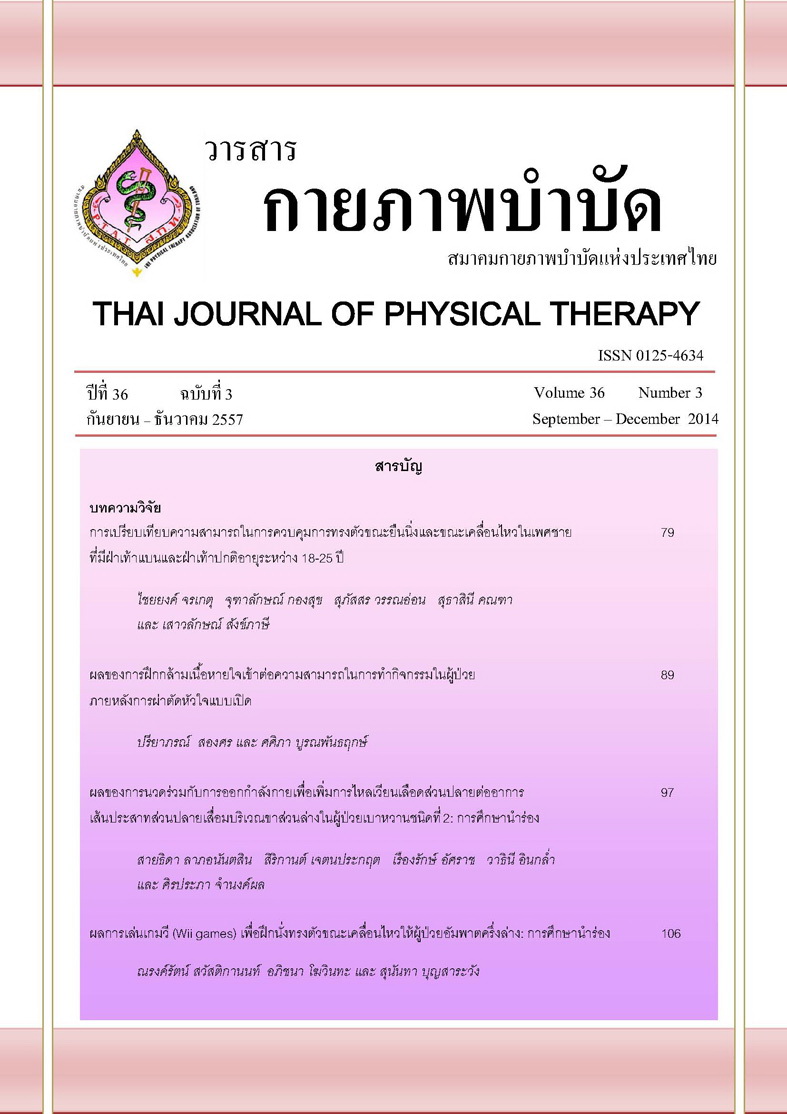ผลของการนวดร่วมกับการออกกำลังกายเพื่อเพิ่มการไหลเวียนเลือดส่วนปลายต่ออาการเส้นประสาทส่วนปลายเสื่อมบริเวณขาส่วนล่างในผู้ป่วยเบาหวานชนิดที่ 2: การศึกษานำร่อง
Main Article Content
บทคัดย่อ
ภาวะเส้นประสาทส่วนปลายเสื่อมบริเวณขาส่วนล่างพบได้บ่อยในผู้ป่วยเบาหวาน เพราะระดับน้ำตาลในเลือดที่สูงเรื้อรังจะทำลายผนังหลอดเลือดที่เลี้ยงเส้นประสาท ทำให้เกิดการเสื่อมของเส้นประสาท ส่งผลให้ผู้ป่วยมีอาการรับความรู้สึกบกพร่องและอ่อนแรงของกล้ามเนื้อ จากการทบทวนวรรณกรรมพบว่าการนวดและการออกกำลังกายสามารถเพิ่มการไหลเวียนเลือด อีกทั้งการออกกำลังกายยังสามารถช่วยลดระดับน้ำตาลในเลือดได้ การศึกษานี้จึงมีวัตถุประสงค์เพื่อศึกษาผลของการนวดร่วมกับการออกกำลังกายเพื่อเพิ่มการไหลเวียนเลือดส่วนปลายต่ออาการเส้นประสาทส่วนปลายเสื่อมบริเวณขาส่วนล่างในผู้ป่วยเบาหวานชนิดที่ 2 วิธีการวิจัย อาสาสมัครที่มีภาวะเส้นประสาทส่วนปลายเสื่อมบริเวณขาส่วนล่างจากเบาหวานชนิดที่ 2 จำนวน 13 คน อายุเฉลี่ย 59.92±8.45 ปี สุ่มแบ่ง 2 กลุ่มคือ กลุ่มนวด (n=9) และกลุ่มนวดร่วมกับการออกกำลังกาย (n=4) ทุกคนรับการตรวจประเมินอาการเส้นประสาทส่วนปลายเสื่อมด้วย Michigan Neuropathy Screening Instrument (MNSI) และวัดแรงกล้ามเนื้อ ankle dorsiflexor (DF) และ plantar flexor (PF) ด้วย hand-held dynamometer กลุ่มนวด (M) ได้รับการสอนนวดเท้าและขาส่วนล่าง (นวด40 นาที/ครั้ง) สำหรับกลุ่มนวดร่วมกับการออกกำลังกาย (ME) ได้รับการสอนนวดและออกกำลังกาย (นวด15 นาที และออกกำลังกาย 25 นาที, รวม40 นาที/ครั้ง) โดยให้ทั้งสองกลุ่มฝึกปฏิบัติตามโปรแกรมที่ได้รับด้วยตนเองที่บ้าน 3 ครั้ง/สัปดาห์ เป็นระยะเวลา 4 สัปดาห์ จากนั้นทุกคนได้รับการตรวจประเมิน MNSI, DF และ PF อีกครั้ง เปรียบเทียบข้อมูลระหว่างก่อน-หลังการฝึกภายในกลุ่มด้วยสถิติ Wilcoxon matched-pairs signed-ranks test และเปรียบเทียบข้อมูลระหว่างกลุ่มด้วยสถิติ Mann-Whitney U test ผลการวิจัย พบว่า ค่าคะแนน MNSI หลังฝึกของกลุ่ม M กับ ME ลดลงจากก่อนฝึกอย่างมีนัยสำคัญทางสถิติที่ (p=0.004 และ p=0.034 ตามลำดับ) แต่ไม่พบความแตกต่างระหว่างทั้งสองกลุ่ม และพบผลของการฝึกทำให้แรงกล้ามเนื้อ PF ของกลุ่ม ME เพิ่มขึ้นมากกว่ากลุ่ม M อย่างมีนัยสำคัญ (p=0.045) ส่วนแรงกล้ามเนื้อ DF เพิ่มขึ้นจากก่อนฝึกเฉพาะในกลุ่ม ME เท่านั้น (p=0.034) สรุปการศึกษานำร่องนี้พบว่าการนวดช่วยบรรเทาอาการเส้นประสาทส่วนปลายเสื่อมโดยสามารถช่วยให้การรับความรู้สึกดีขึ้น ขณะที่ การนวดร่วมกับการออกกำลังกายเพื่อเพิ่มการไหลเวียนเลือดส่วนปลายของการศึกษานี้ช่วยให้การรับความรู้สึกดีขึ้นและช่วยเพิ่มแรงกล้ามเนื้อ DF และ PF ขึ้นร่วมด้วยอย่างมีนัยสำคัญ อย่างไรก็ตาม ควรมีการศึกษาเพิ่มเติมในจำนวนกลุ่มตัวอย่างที่มีขนาดใหญ่ขึ้นเพื่อยืนยันผลการศึกษาให้มีความน่าเชื่อถือมากยิ่งขึ้น
Article Details
เอกสารอ้างอิง
2. สำนักระบาดวิทยากรมควบคุมโรคกระทรวงสาธารณสุข. Clinical Complication in type 2 diabetic patients 2554; 2012 [cited 2014 Oct 29]. Available from: http://www.dms.moph. go.th/imrta/images/aw.pdf.
3. Edwards JL, Vincent AM, Cheng HT, Feldman EL. Diabetic neuropathy: mechanisms to management. Pharmacol Ther, 2008; 120: 1-34.
4. Callaghan BC, Cheng HT, Stables CL, Smith AL, Feldman EL. Diabetic neuropathy: clinical manifestations and current treatments. Lancet Neurol, 2012; 11: 521-34.
5. Dinh TL, Veves A. A review of the mechanisms implicated in the pathogenesis of the diabetic foot. Int J Low Extrem Wounds, 2005; 4: 154-9.
6. Edwards BG, Palmer J. Effects of massage therapy on African Americans with type 2 diabetes mellitus: apilot study. Complementary Health Practice Review, 2010; 15: 149-55.
7. สุวัฒน์ ธนกรนุวัฒน์, Hua W, Ping F, Jiakang L, Fengxia L, Bangguo C และคณะ. ประสิทธิผลของการฝังเข็มรักษาอาการชาปลายเท้าในผู้ป่วยเบาหวาน. วารสารการแพทย์แผนไทยและการแพทย์ทางเลือก, 2555; 10: 177-86.
8. Weerapong P, Hume PA, Kolt GS. The mechanisms of massage and effects on performance, muscle recovery and injury prevention. Sports Med, 2005; 35: 235-56.
9. Kurth-Kraczek EJ, Hirshman MF, Goodyear LJ, Winder WW. 5' AMP-activated protein kinase activation causes GLUT4 translocation in skeletal muscle. Diabetes, 1999; 48: 1667-71.
10. American Diabetes Association. Diabetes mellitus and exercise. Diabetes Care, 2002; 25(suppl1): 564-8.
11. Kluding PM, Pasnoor M, Singh R, Jernigan S, Farmer K, Rucker J, et al. The effect of exercise on neuropathic symptoms, nerve function, and cutaneous innervation in people with diabetic peripheral neuropathy. J Diabetes Complications, 2012; 26: 424-9.
12. Balducci S, Iacobellis G, Parisi L, Di Biase N, Calandriello E, Leonetti F, et al. Exercise training can modify the natural history of diabetic peripheral neuropathy. J Diabetes Complications, 2006; 20: 216-23.
13. Mueller MJ, Tuttle LJ, Lemaster JW, Strube MJ, McGill JB, Hastings MK, et al. Weight-bearing versus nonweight-bearing exercise for persons with diabetes and peripheral neuropathy: a randomized controlled trial. Arch Phys Med Rehabil, 2013; 94: 829-38.
14.Hamburg NM, Balady GJ. Exercise rehabilitation in peripheral artery disease: functional impact and mechanisms of benefits. Circulation, 2011; 123: 87-97.
15. Kisner C, Colby LA. Therapeutic exercise: foundations and techniques. 2nd ed. Singapore: Info Access & Distribution; 1991.
16. Herman WH, Pop-Busui R, Braffett BH, Martin CL, Cleary PA, Albers JW, et al. Use of the Michigan neuropathy screening instrument as a measure of distal symmetrical peripheral neuropathy in type 1 diabetes: results from the diabetes control and complications trial/epidemiology of diabetes interventions and complications. Diabet Med, 2012; 29: 937-44.
17. MNSI, Michigan University. 2000 [cited 2014Oct29] Available from: http://www.med. umich.edu/mdrtc/profs/documents/svi/MNSI_ patient.pdf.
18. Moghtaderi A, Bakhshipour A, Rashidi H. Validation of Michigan neuropathy screening instrument for diabetic peripheral neuropathy. Clin Neurol Neurosurg, 2006; 108: 477-81.
19. จิตต์สกุล ศกุนะสิงห์. ประสิทธิผลของการนวดเท้าในผู้ป่วยเบาหวานที่มีอาการเท้าชา. วารสารโรงพยาบาลร้อยเอ็ด, กาฬสินธุ์, มหาสารคาม, 2012; 19: 36-44
20. Jeanette E, Thomas D. Is massage useful in the management of diabetes? Diabetic spectrum, 2001; 14: 218-224.
21. ประโยชน์ บุญสินสุข. การบำบัดด้วยมือ Manual Therapy. พิมพ์ครั้งที่1. กรุงเทพฯ: เอสพีการพิมพ์; 2552: 46-74.
22. Downer S, Mattacola C. Isometric muscle-force measurements obtained by handheld dynamometry. Athletic Therapy Today, 2003; 3: 38-40.
23. สมลักษณ์ หนูจันทร์, สมชาย รัตนทองคำ. ผลการนวดไทยและการกดจุดต่ออาการชาปลายเท้าในผู้ป่วยเบาหวาน: ศึกษากรณีที่สถานีอนามัยบ้านโพนสว่างตำบลจรเข้ อำเภอหนองเรือ จังหวัดขอนแก่น. J Med Tech Phys Ther, 2008; 20: 139-47.
24. Cole JD, Sedgwick EM. The perceptions of force and of movement in a man without large myelinated sensory afferents below the neck. J Physiol, 1992; 449: 503-15.
25. Ward RE, Caserotti P, Faulkner K, Boudreau RM, Zivkovic S, Lee C, et al. Peripheral nerve function and lower extremity muscle power in older men. Arch Phys Med Rehabil, 2014; 95: 726-33.
26. Patten C, Kamen G. Adaptations in motor unit discharge activity with force control training in young and older human adults. Eur J Appl Physiol, 2000; 83: 128-43.
27. Clamann HP. Motor unit recruitment and the gradation of muscle force. Phys Ther, 1993; 73: 830-43.


